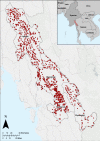Longitudinal trends in malaria testing rates in the face of elimination in eastern Myanmar: a 7-year observational study
- PMID: 34551751
- PMCID: PMC8459519
- DOI: 10.1186/s12889-021-11749-x
Longitudinal trends in malaria testing rates in the face of elimination in eastern Myanmar: a 7-year observational study
Abstract
Background: Providing at-risk communities with uninterrupted access to early diagnosis and treatment is a key component in reducing malaria transmission and achieving elimination. As programmes approach malaria elimination targets it is critical that each case is tested and treated early, which may present a challenge when the burden of malaria is reduced. In this paper we investigate whether malaria testing rates decline over time and assess the impacts of integrating malaria and non-malaria services on testing rates in the malaria elimination task force (METF) programme in the Kayin state of Myanmar.
Methods: A retrospective analysis was conducted using weekly collected data on testing rates from a network of more than 1200 malaria posts during the period from 2014 to 2020. To determine whether monthly testing rates changed over the years of programme operations, and whether integrating malaria and non-malaria services impacted these testing rates, we fitted negative binomial mixed-effects regression models to aggregate monthly data, accounting for malaria seasonal variation.
Results: In the first year of malaria post operation, testing rates declined, correlating with a decline in attendance by people from outside the malaria post catchment area, but then remained fairly constant (the Rate Ratio (RR) for 2nd versus 1st year open ranged from 0.68 to 0.84 across the four townships included in the analysis, the RR for 3rd to 6th year versus 1st year open were similar, ranging from 0.59-0.78). The implementation of a training programme, which was intended to expand the role of the malaria post workers, had minimal impact on testing rates up to 24 months after training was delivered (RR for integrated versus malaria-only services ranged from 1.00 to 1.07 across METF townships).
Conclusion: Despite the decline in malaria incidence from 2014 to 2020, there has been no decline in the malaria testing rate in the METF programme after the establishment of the complete malaria post network in 2016. While the integration of malaria posts with other health services provides benefits to the population, our evaluation questions the necessity of integrated services in maintaining malaria testing rates in areas approaching elimination of malaria.
Keywords: Community health worker; Elimination; Integrated health services; Malaria; P. falciparum; P. vivax; RDT; Testing rate.
© 2021. The Author(s).
Conflict of interest statement
The authors declare that they have no competing interests.
Figures





References
-
- Battle KE, Lucas TCD, Nguyen M, Howes RE, Nandi AK, Twohig KA, Pfeffer DA, Cameron E, Rao PC, Casey D, Gibson HS, Rozier JA, Dalrymple U, Keddie SH, Collins EL, Harris JR, Guerra CA, Thorn MP, Bisanzio D, Fullman N, Huynh CK, Kulikoff X, Kutz MJ, Lopez AD, Mokdad AH, Naghavi M, Nguyen G, Shackelford KA, Vos T, Wang H, Lim SS, Murray CJL, Price RN, Baird JK, Smith DL, Bhatt S, Weiss DJ, Hay SI, Gething PW. Mapping the global endemicity and clinical burden of plasmodium vivax, 2000-17: a spatial and temporal modelling study. Lancet. 2019;394(10195):332–343. doi: 10.1016/S0140-6736(19)31096-7. - DOI - PMC - PubMed
-
- Weiss DJ, Lucas TCD, Nguyen M, Nandi AK, Bisanzio D, Battle KE, Cameron E, Twohig KA, Pfeffer DA, Rozier JA, Gibson HS, Rao PC, Casey D, Bertozzi-Villa A, Collins EL, Dalrymple U, Gray N, Harris JR, Howes RE, Kang SY, Keddie SH, May D, Rumisha S, Thorn MP, Barber R, Fullman N, Huynh CK, Kulikoff X, Kutz MJ, Lopez AD, Mokdad AH, Naghavi M, Nguyen G, Shackelford KA, Vos T, Wang H, Smith DL, Lim SS, Murray CJL, Bhatt S, Hay SI, Gething PW. Mapping the global prevalence, incidence, and mortality of plasmodium falciparum, 2000-17: a spatial and temporal modelling study. Lancet. 2019;394(10195):322–331. doi: 10.1016/S0140-6736(19)31097-9. - DOI - PMC - PubMed
-
- WHO. World Malaria Report. 2020. https://www.who.int/publications/i/item/9789240015791. Accessed 11 Jan 2021.
-
- Rogier E, Hamre KES, Joseph V, Plucinski MM, Presume J, Romilus I, Mondelus G, Elisme T, van den Hoogen L, Lemoine JF, Drakeley C, Ashton RA, Chang MA, Existe A, Boncy J, Stresman G, Druetz T, Eisele TP. Conventional and high-sensitivity malaria rapid diagnostic test performance in 2 transmission settings: Haiti 2017. J Infect Dis. 2019;221:786–795. doi: 10.1093/infdis/jiz525. - DOI - PMC - PubMed
Publication types
MeSH terms
Grants and funding
LinkOut - more resources
Full Text Sources
Medical
Research Materials

